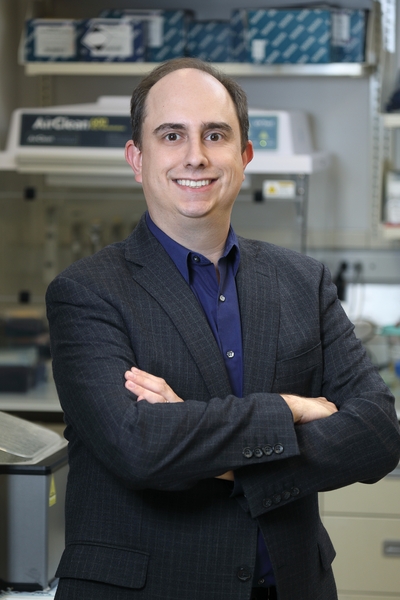A Crystal Ball for Prostate Cancer Treatment
IRP’s Dr. Adam Sowalsky Looks to Tumors’ Origins to Predict Outcomes

IRP researchers led by Dr. Adam Sowalsky are investigating tumor cells' inherent traits in order to predict how they will respond to treatment.
Imagine two men, both diagnosed with prostate cancer. For one, the disease will remain a quiet shadow, never seriously threatening his life. For the other, it will become an aggressive adversary, resisting treatments and altering his future. This June, as Men's Health Month brings such realities into focus, a critical question echoes in clinics and labs: how can we identify early on which cancer will turn dangerous, and how can we use that knowledge to change a patient's outcome for the better?
IRP senior investigator Adam G. Sowalsky, Ph.D., believes the answer lies not just in how cancer adapts during treatment, but in the evolutionary traits it already possesses when it first emerges.
"My research broadly asks the question, ‘Why do so many men get prostate cancer but die from something else?’" he says.
It’s a question that cuts to the heart of a dilemma: treating slow-growing cancers too aggressively can cause unnecessary harm, but taking it easy on aggressive ones can be fatal. Dr. Sowalsky’s groundbreaking work suggests that the clues to a tumor's future ferocity are often embedded in its genetic makeup from its earliest days — a hidden ‘tell’ that his team is learning to read by looking through an evolutionary lens. This isn't just about understanding cancer; it's about fundamentally changing how we fight it by identifying which tumors are primed to be dangerous before they ever get the chance to do harm.
The Evolutionary Insight: Some Cancers Are 'Born' Resistant

Dr. Adam Sowalsky
The traditional view of what makes certain cancers more dangerous than others often focuses only on how cancer cells develop resistance to therapies after treatment begins — a process of adaptation. However, Dr. Sowalsky’s research, rooted in evolutionary biology, champions a pivotal, alternative idea.
"The logical hypothesis to test," he asserts, "is that these cancer cells that resist treatment already exist before treatment starts."
That viewpoint rests on the fact that a tumor is not a uniform mass, but a collection of individual cells that each has its own minor genetic variations. From the start, a small, almost undetectable fraction of those cells might already possess the genetic tools to survive therapy. Treatment, then, doesn't just fight the cancer; it acts as a powerful selective force, inadvertently allowing these highly resilient cells — already adapted for survival — to flourish in the same way that our distant mammalian ancestors did after an asteroid wiped out the dinosaurs.
“A single prostate cancer can take on different properties and look like different cancers, even though it came from the same cell of origin,” Dr. Sowalsky explains.
Consequently, if scientists can identify the cancer cells that come pre-equipped to shrug off treatment by deciphering the tumor's initial genetic blueprint, the impact on patients could be immense. Instead of a one-size-fits-all approach, treatments could be tailored from day one, deploying the right strategy against the right foe and potentially sparing men from experiencing debilitating side effects from therapies that will ultimately prove ineffective.
A Glimmer of the Future: The HER2 Discovery
This isn't just a compelling theory; Dr. Sowalsky's team at NIH is already translating it into actionable science. In a recent clinical trial, his team studied men with high-risk prostate cancer. A standard drug worked wonders for some, but for nearly 60 percent, it fell short. The key to this difference, Dr. Sowalsky’s team discovered, lay in biopsies taken before treatment ever started.
Their analysis revealed a striking pattern: prior to treatment, many of the unresponsive tumors showed high activity in a molecular pathway called HER2. While HER2 is a familiar target in breast and lung cancer, its prominent role in early-stage prostate cancers was a significant revelation. This wasn't a case of the cancer adapting; the HER2 activity was already revved up before treatment began.
Unlocking these intricate biological secrets requires more than just brilliant ideas; it demands sophisticated tools and a uniquely collaborative environment — precisely what NIH provides. Dr. Sowalsky’s lab uses laser capture microdissection, a technique allowing them to meticulously isolate tiny groups of cells, or even individual cells, from a set collected during a biopsy. This painstaking work yields ultra-pure samples, essential for accurately reading the distinct genetic stories within a tumor.

Pathologist and IRP postdoctoral fellow Sumeyra Kartal selects areas on a section of tissue for further analysis, which the laser capture microdissection equipment next to her will then cut out of the tissue sample using a laser.
The isolated cells then tell their tales through DNA and RNA sequencing, allowing the team to map the cells’ genetic instructions and active pathways. By comparing these ‘first drafts’ from pre-treatment biopsies with samples taken after treatment has begun, Dr. Sowalsky’s team can trace the impact of pre-existing traits on treatment response.
"This is actually why the initial biopsy is so important: because we can't go back in time and get it again,” Dr. Sowalsky says.
Transforming Treatment, One Discovery at a Time
After making that discovery about HER2, the path forward became clear, especially since drugs that target the HER2 pathway are already FDA-approved and used for other cancers.
"Since the drugs already exist," Dr. Sowalsky says, "the next logical step is to design a clinical trial — and what better place to do that than at the NIH Clinical Center?"

Dr. Sowalsky's work may one day lead to approaches that can help doctors make better treatment decisions for their cancer patients.
"I could not do this work without clinical colleagues," he adds. "NIH is really special because every clinician is also a researcher. The type of close relationship I built with our clinical teams — I've never seen it elsewhere."
And while the HER2 finding may prove powerful, Dr. Sowalsky’s vision extends further. His lab is on a quest for other biomarkers — early warning signs in a tumor's genetic code that can predict its future behavior.
"It's a home run when a biomarker becomes a new therapeutic opportunity," he says.
All this work deepens our understanding of how cancer evolves and becomes treatment-resistant, but more importantly, it offers patients the promise of true precision medicine: understanding their specific cancer's inherent nature and using that information to choose the most effective treatment from the outset.
"The most exciting part of the work that I do at NIH,” Dr. Sowalsky says, “is working with patients and their providers, who are both engaged and eager to not only treat the disease, but help others come up with new approaches to treating cancer in the future."
Subscribe to our weekly newsletter to stay up-to-date on the latest breakthroughs in the NIH Intramural Research Program.
Related Blog Posts
This page was last updated on Wednesday, June 4, 2025
